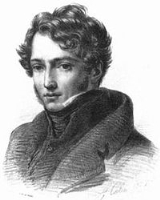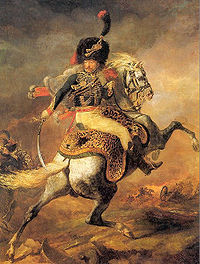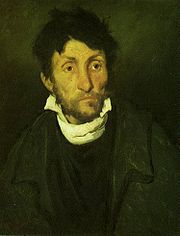
Théodore Géricault
Encyclopedia
Jean-Louis André Théodore Géricault (26 September 1791 – 26 January 1824) was a profoundly influential French artist, painter and lithographer, known for The Raft of the Medusa and other paintings. Although he died young, he became one of the pioneers of the Romantic movement
.
 Born in Rouen
Born in Rouen
, France, Géricault was educated in the tradition of English sporting art by Carle Vernet and classical figure composition by Pierre-Narcisse Guérin
, a rigorous classicist who disapproved of his student's impulsive temperament, but recognized his talent.
Géricault soon left the classroom, choosing to study at the Louvre
instead, where (from 1810 to 1815) he copied from paintings by Peter Paul Rubens, Titian
, Diego Velázquez
, and Rembrandt. It was during this period at the Louvre, that he found a vitality which he preferred to the prevailing school of Neoclassicism
. Much of his time was spent in Versailles
, where he found the stables of the palace open to him, and where he gained his knowledge of the anatomy
and action of horses.
, exhibited at the Paris Salon
of 1812, revealed the influence of the style of Rubens and an interest in the depiction of contemporary subject matter. This youthful success, ambitious and monumental, was followed by a change in direction: for the next several years Géricault produced a series of small studies of horses and cavalrymen. He exhibited Wounded Cuirassier at the Salon in 1814, a work more labored and less well received. Géricault in a fit of disappointment entered the army and served for a time in the garrison of Versailles. In the nearly two years that followed the 1814 Salon, he also underwent a self-imposed study of figure construction and composition, all the while evidencing a personal predilection for drama and expressive force.
A trip to Florence
, Rome, and Naples (1816–17), prompted in part by the desire to flee from a romantic entanglement with his aunt, ignited a fascination with Michelangelo
. Rome itself inspired the preparation of a monumental canvas, the Race of the Barberi Horses, a work of epic composition and abstracted theme that promised to be "entirely without parallel in its time". In the event, Géricault never completed the painting, and returned to France. In 1821, he painted The Derby of Epsom
.
 Géricault continually returned to the military themes of his early paintings, and the series of lithographs he undertook on military subjects after his return from Italy are considered some of the earliest masterworks in that medium. Perhaps his most significant, and certainly most ambitious work, is The Raft of the Medusa (1818–1819), which depicted the aftermath of a contemporary French shipwreck, Meduse in which the captain had left the crew and passengers to die. The incident became a national scandal, and Géricault's dramatic interpretation presented a contemporary tragedy on a monumental scale. The painting's notoriety stemmed from its indictment of a corrupt establishment, but it also dramatized a more eternal theme, that of man's struggle with nature. It surely excited the imagination of the young Eugène Delacroix
Géricault continually returned to the military themes of his early paintings, and the series of lithographs he undertook on military subjects after his return from Italy are considered some of the earliest masterworks in that medium. Perhaps his most significant, and certainly most ambitious work, is The Raft of the Medusa (1818–1819), which depicted the aftermath of a contemporary French shipwreck, Meduse in which the captain had left the crew and passengers to die. The incident became a national scandal, and Géricault's dramatic interpretation presented a contemporary tragedy on a monumental scale. The painting's notoriety stemmed from its indictment of a corrupt establishment, but it also dramatized a more eternal theme, that of man's struggle with nature. It surely excited the imagination of the young Eugène Delacroix
, who posed for one of the dying figures.
 The classical depiction of the figures and structure of the composition stand in contrast to the turbulence of the subject, and creates an important bridge between the styles of neo-classicism and romanticism
The classical depiction of the figures and structure of the composition stand in contrast to the turbulence of the subject, and creates an important bridge between the styles of neo-classicism and romanticism
. The painting fuses many influences: the Last Judgment
of Michelangelo
, the monumental approach to contemporary events by Antoine-Jean Gros
, figure groupings by Henry Fuseli
, and possibly the painting Watson and the Shark
by John Singleton Copley
.
The painting ignited political controversy when first exhibited at the Paris Salon of 1819; it then traveled to England in 1820, accompanied by Géricault himself, where it received much praise. While in London, Géricault witnessed urban poverty, made drawings of his impressions, and published lithographs based on these observations which were free of sentimentality. He associated much there with Charlet
, the lithographer and caricaturist.
, a pioneer in psychiatric medicine, with each subject exhibiting a different affliction. There are five remaining portraits from the series, including Insane Woman
. The paintings are noteworthy for their bravura style, expressive realism, and for their documenting of the psychological discomfort of individuals, made all the more poignant by the history of insanity in Géricault's family, as well as the artist's own fragile mental health. His observations of the human subject were not confined to the living, for some remarkable still-lifes—painted studies of severed heads and limbs—have also been ascribed to the artist.
 Géricault's last efforts were directed toward preliminary studies for several epic compositions, including the Opening of the Doors of the Spanish Inquisition and the African Slave Trade. The preparatory drawings suggest works of great ambition, but Géricault's waning health intervened.
Géricault's last efforts were directed toward preliminary studies for several epic compositions, including the Opening of the Doors of the Spanish Inquisition and the African Slave Trade. The preparatory drawings suggest works of great ambition, but Géricault's waning health intervened.
infection, he died in Paris in 1824 after a long period of suffering. His bronze figure reclines, brush in hand, on his tomb at Père Lachaise Cemetery
in Paris, above a low-relief panel of The Raft of the Medusa.
Romanticism
Romanticism was an artistic, literary and intellectual movement that originated in the second half of the 18th century in Europe, and gained strength in reaction to the Industrial Revolution...
.
Early life

Rouen
Rouen , in northern France on the River Seine, is the capital of the Haute-Normandie region and the historic capital city of Normandy. Once one of the largest and most prosperous cities of medieval Europe , it was the seat of the Exchequer of Normandy in the Middle Ages...
, France, Géricault was educated in the tradition of English sporting art by Carle Vernet and classical figure composition by Pierre-Narcisse Guérin
Pierre-Narcisse Guérin
Pierre-Narcisse, baron Guérin was a French painter.-Biography:Guérin was born in Paris.A pupil of Jean-Baptiste Regnault, he carried off one of the three grands prix offered in 1796, in consequence of the competition not having taken place since 1793...
, a rigorous classicist who disapproved of his student's impulsive temperament, but recognized his talent.
Géricault soon left the classroom, choosing to study at the Louvre
Louvre
The Musée du Louvre – in English, the Louvre Museum or simply the Louvre – is one of the world's largest museums, the most visited art museum in the world and a historic monument. A central landmark of Paris, it is located on the Right Bank of the Seine in the 1st arrondissement...
instead, where (from 1810 to 1815) he copied from paintings by Peter Paul Rubens, Titian
Titian
Tiziano Vecelli or Tiziano Vecellio Tiziano Vecelli or Tiziano Vecellio Tiziano Vecelli or Tiziano Vecellio (c. 1488/1490 – 27 August 1576 better known as Titian was an Italian painter, the most important member of the 16th-century Venetian school. He was born in Pieve di Cadore, near...
, Diego Velázquez
Diego Velázquez
Diego Rodríguez de Silva y Velázquez was a Spanish painter who was the leading artist in the court of King Philip IV. He was an individualistic artist of the contemporary Baroque period, important as a portrait artist...
, and Rembrandt. It was during this period at the Louvre, that he found a vitality which he preferred to the prevailing school of Neoclassicism
Neoclassicism
Neoclassicism is the name given to Western movements in the decorative and visual arts, literature, theatre, music, and architecture that draw inspiration from the "classical" art and culture of Ancient Greece or Ancient Rome...
. Much of his time was spent in Versailles
Versailles
Versailles , a city renowned for its château, the Palace of Versailles, was the de facto capital of the kingdom of France for over a century, from 1682 to 1789. It is now a wealthy suburb of Paris and remains an important administrative and judicial centre...
, where he found the stables of the palace open to him, and where he gained his knowledge of the anatomy
Anatomy
Anatomy is a branch of biology and medicine that is the consideration of the structure of living things. It is a general term that includes human anatomy, animal anatomy , and plant anatomy...
and action of horses.
Success
His first major work, The Charging ChasseurThe Charging Chasseur
The Charging Chasseur, or An Officer of the Imperial Horse Guards Charging is an oil painting on canvas of about 1812 by the French painter Théodore Géricault, portraying a mounted Napoleonic cavalry officer, ready to attack...
, exhibited at the Paris Salon
Paris Salon
The Salon , or rarely Paris Salon , beginning in 1725 was the official art exhibition of the Académie des Beaux-Arts in Paris, France. Between 1748–1890 it was the greatest annual or biannual art event in the Western world...
of 1812, revealed the influence of the style of Rubens and an interest in the depiction of contemporary subject matter. This youthful success, ambitious and monumental, was followed by a change in direction: for the next several years Géricault produced a series of small studies of horses and cavalrymen. He exhibited Wounded Cuirassier at the Salon in 1814, a work more labored and less well received. Géricault in a fit of disappointment entered the army and served for a time in the garrison of Versailles. In the nearly two years that followed the 1814 Salon, he also underwent a self-imposed study of figure construction and composition, all the while evidencing a personal predilection for drama and expressive force.
A trip to Florence
Florence
Florence is the capital city of the Italian region of Tuscany and of the province of Florence. It is the most populous city in Tuscany, with approximately 370,000 inhabitants, expanding to over 1.5 million in the metropolitan area....
, Rome, and Naples (1816–17), prompted in part by the desire to flee from a romantic entanglement with his aunt, ignited a fascination with Michelangelo
Michelangelo
Michelangelo di Lodovico Buonarroti Simoni , commonly known as Michelangelo, was an Italian Renaissance painter, sculptor, architect, poet, and engineer who exerted an unparalleled influence on the development of Western art...
. Rome itself inspired the preparation of a monumental canvas, the Race of the Barberi Horses, a work of epic composition and abstracted theme that promised to be "entirely without parallel in its time". In the event, Géricault never completed the painting, and returned to France. In 1821, he painted The Derby of Epsom
The Derby of Epsom
The Derby of Epsom, also traditionally named the 1821 Derby at Epsom, is an 1821 painting by Théodore Géricault.Fascinated by the horses, Géricault made many paintings portraying them. Working for a while at the imperial stables, he had the opportunity to study in detail and made numerous...
.
The Raft of the Medusa

Eugène Delacroix
Ferdinand Victor Eugène Delacroix was a French Romantic artist regarded from the outset of his career as the leader of the French Romantic school...
, who posed for one of the dying figures.

Romanticism
Romanticism was an artistic, literary and intellectual movement that originated in the second half of the 18th century in Europe, and gained strength in reaction to the Industrial Revolution...
. The painting fuses many influences: the Last Judgment
The Last Judgment (Michelangelo)
The Last Judgment is a canonical fresco by the Italian Renaissance master Michelangelo executed on the altar wall of the Sistine Chapel in Vatican City...
of Michelangelo
Michelangelo
Michelangelo di Lodovico Buonarroti Simoni , commonly known as Michelangelo, was an Italian Renaissance painter, sculptor, architect, poet, and engineer who exerted an unparalleled influence on the development of Western art...
, the monumental approach to contemporary events by Antoine-Jean Gros
Antoine-Jean Gros
Baron Antoine-Jean Gros , also known as Jean-Antoine Gros, was both a French History and neoclassical painter.-Early life and training:...
, figure groupings by Henry Fuseli
Henry Fuseli
Henry Fuseli was a British painter, draughtsman, and writer on art, of Swiss origin.-Biography:...
, and possibly the painting Watson and the Shark
Watson and the Shark
Watson and the Shark is the title of a 1778 oil painting by John Singleton Copley, depicting the rescue of Brook Watson from a shark attack in Havana, Cuba. The original of three versions by Copley is in the National Gallery of Art, Washington, D.C.....
by John Singleton Copley
John Singleton Copley
John Singleton Copley was an American painter, born presumably in Boston, Massachusetts, and a son of Richard and Mary Singleton Copley, both Irish. He is famous for his portrait paintings of important figures in colonial New England, depicting in particular middle-class subjects...
.
The painting ignited political controversy when first exhibited at the Paris Salon of 1819; it then traveled to England in 1820, accompanied by Géricault himself, where it received much praise. While in London, Géricault witnessed urban poverty, made drawings of his impressions, and published lithographs based on these observations which were free of sentimentality. He associated much there with Charlet
Nicolas Toussaint Charlet
Nicolas Toussaint Charlet , French designer and painter, more especially of military subjects, was born in Paris....
, the lithographer and caricaturist.
Later work
After his return to France in 1821, Géricault was inspired to paint a series of ten portraits of the insane, the patients of a friend, Dr. Étienne-Jean GeorgetÉtienne-Jean Georget
Étienne-Jean Georget was a French psychiatrist who was a native of Vernon-on-Brenne. He studied medicine in Tours and Paris, and afterwards worked at the Salpêtrière. In Paris he was a student and assistant to Philippe Pinel and Jean-Étienne Dominique Esquirol.Georget specialized in the study of...
, a pioneer in psychiatric medicine, with each subject exhibiting a different affliction. There are five remaining portraits from the series, including Insane Woman
Insane Woman
Insane Woman is an 1822 oil on canvas painting by Théodore Géricault in a series of work Géricault did on the mentally insane. It is housed in the Musée des Beaux-Arts de Lyon, France....
. The paintings are noteworthy for their bravura style, expressive realism, and for their documenting of the psychological discomfort of individuals, made all the more poignant by the history of insanity in Géricault's family, as well as the artist's own fragile mental health. His observations of the human subject were not confined to the living, for some remarkable still-lifes—painted studies of severed heads and limbs—have also been ascribed to the artist.

Death
Weakened by riding accidents and chronic tubercularTuberculosis
Tuberculosis, MTB, or TB is a common, and in many cases lethal, infectious disease caused by various strains of mycobacteria, usually Mycobacterium tuberculosis. Tuberculosis usually attacks the lungs but can also affect other parts of the body...
infection, he died in Paris in 1824 after a long period of suffering. His bronze figure reclines, brush in hand, on his tomb at Père Lachaise Cemetery
Père Lachaise Cemetery
Père Lachaise Cemetery is the largest cemetery in the city of Paris, France , though there are larger cemeteries in the city's suburbs.Père Lachaise is in the 20th arrondissement, and is reputed to be the world's most-visited cemetery, attracting hundreds of thousands of visitors annually to the...
in Paris, above a low-relief panel of The Raft of the Medusa.

